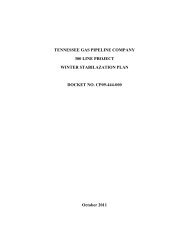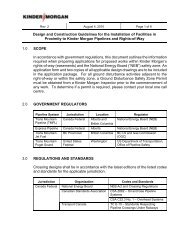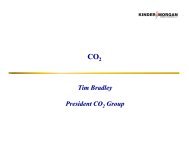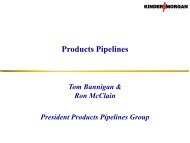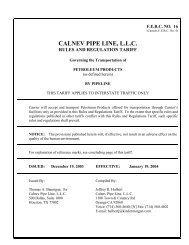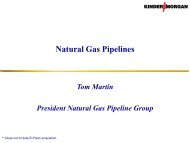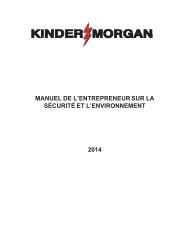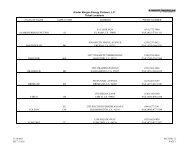Covered Task - Kinder Morgan
Covered Task - Kinder Morgan
Covered Task - Kinder Morgan
Create successful ePaper yourself
Turn your PDF publications into a flip-book with our unique Google optimized e-Paper software.
2. Be able to visually identify leakage3. Be aware of OQ qualification requirements for inspection of atmospheric coatings (<strong>Covered</strong> <strong>Task</strong> 102.09)E. Know procedures to notify Operations prior to operation of valveF. Be able to safely operate the valve to verify that it operates properlyG. Return valve to original position1. Be able to verify original position, using valve stem or valve position indicator rod if availableH. Re-lock in proper position or provide security as appropriate1. Be able to secure locking device, usually chain and lock2. Be able to verify valve is in original positionI. Know proper documentation proceduresJ. Be able to recognize and respond to abnormal operating conditions that might be encountered when performing this covered task.104.08 Moving in-service pipeA. Be able to determine the product type (MSDS, DOT Part 195)1. Know who to contact to determine the product which will be at the job site during the work.2. If product is a Highly Volatile Liquid (HVL), be aware of pressure restrictions and isolation requirements prior to moving the pipe (DOT Part 195.424).B. Profile pipeline.1. Be aware of OQ qualification requirements for locating pipeline (<strong>Covered</strong> <strong>Task</strong> 104.22)2. Be able to determine existing location of pipeline3. Be able to approximately determine local soil conditions (sand, clay, rock, drainage)4. Be able to identify approximate new location of pipelineC. Review pipeline drawings1. Be able to read and understand information on pipeline drawings, such as wall thickness, grade of steel, diameter of pipe, pipe bends, pipe fittings.2. Know procedure for notification to KMEP Environmental Dept. for their review prior to commencement of excavation.3. Ensure that all welds within the area of relocation have been non-destructively tested, if applicable.D. Excavation1. Be aware of KMEP requirements for excavation near the pipeline.2. Be familiar with KMEP procedures for working safely in an excavation3. Be aware of all permit requirements, such as environmental, excavation, etc.4. Be aware of all environmental concerns, such as permitting, water disposition and erosion control.5. When excavating around the pipeline, be able to determine proper depth of excavation to ensure adequate working room around pipeline.6. When excavating around the pipeline, be able to provide adequate support (such as dirt or skids) to exposed pipeline.E. Pipe/coating inspection.1. Be aware of OQ qualification requirements for inspecting buried pipe when exposed (<strong>Covered</strong> <strong>Task</strong> 104.01).F. Moving the pipeline.1. Be aware of steps necessary to prepare new bed, such as crumbing or bedding the ditch2. Be aware of advantages and disadvantages of various mechanical lifting devices (side booms, boom trucks, etc.)3. Understand safe rigging and lifting procedures.4. Be aware of safety precautions associated with lowering the pipeline, such as skid removal, internal pressure restrictions, and local requirements for isolation ofthe pipeline being relocated.5. In areas where little or no slack is available on the pipeline, be aware of how to insure secondary stresses are minimized.Page 20 of 33



